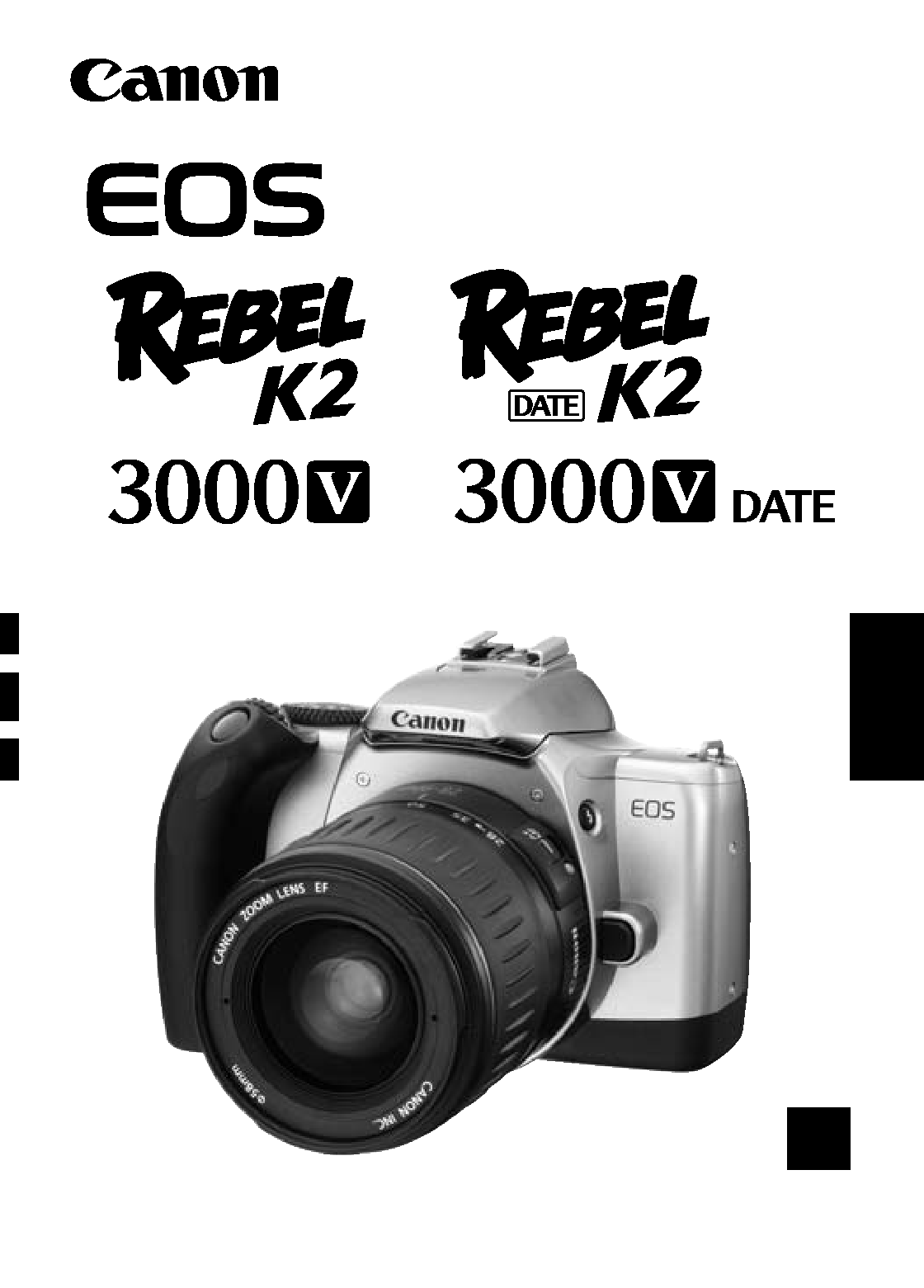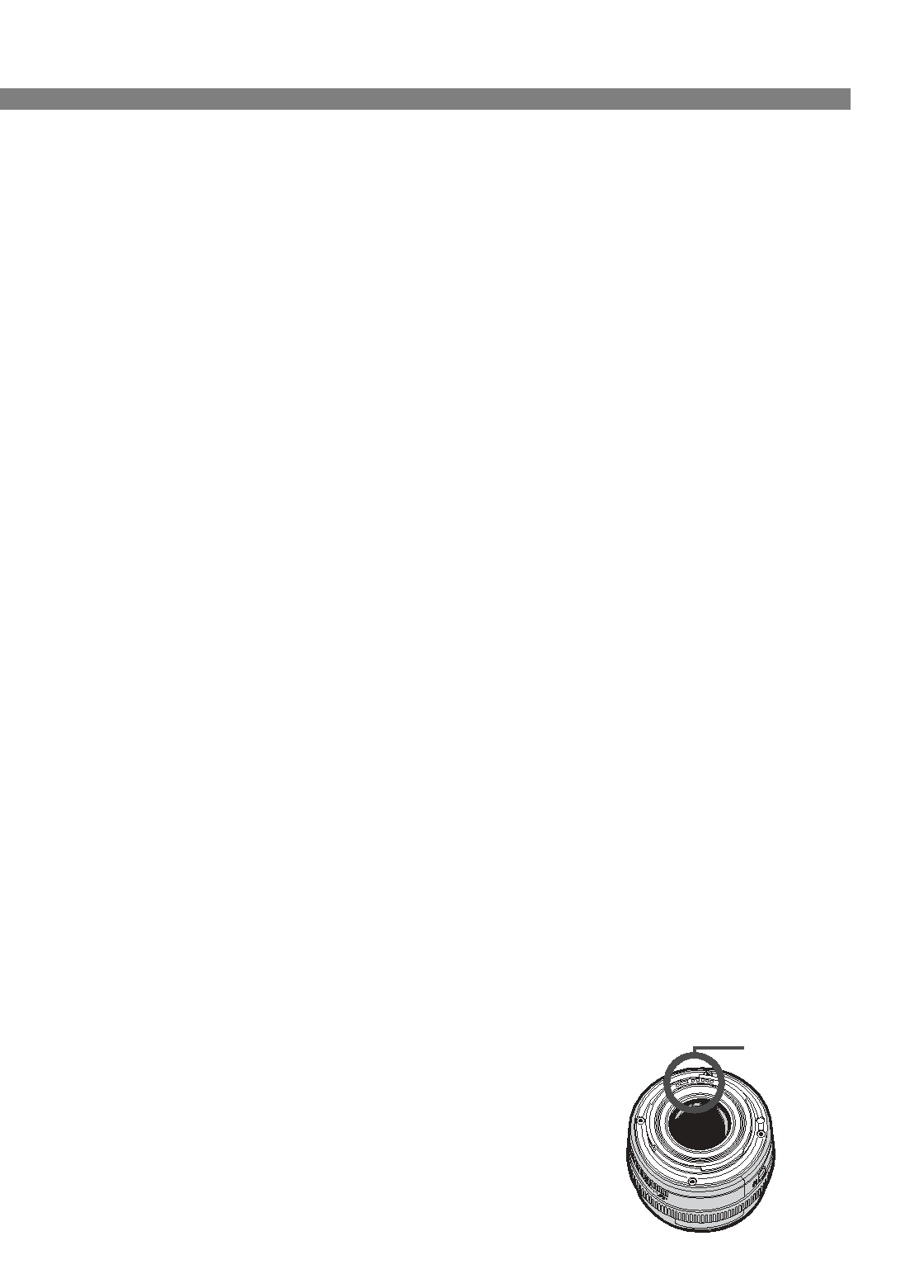
/
/
E
INSTRUCTIONS
English

2
Thank you for purchasing a Canon product.
The EOS REBEL K2 (DATE) / 3000V (DATE) is a very compact
autofocus, single-lens reflex camera. It can be used for a wide
variety of subjects and situations with fully automatic and user-
controlled shooting modes.
Read this Instructions and familiarize yourself with your new camera
before taking pictures.
Also read "Handling Cautions" on page 4 to prevent camera
malfunction and damage.
Keep this instruction booklet handy for easy reference.
Before Using Your Camera
· Before shooting an important event, be sure to take test shots
to make sure the camera operates properly.
· EOS cameras have a lens mount for dedicated operation
(autofocusing, exposure control, etc.) with Canon EF lenses.
Using a non-Canon EF lens with an EOS camera may not
result in proper camera or lens operation. Note that the
warranty does not cover any camera malfunction or damage
occurring with the use of non-Canon products.
Conventions Used in this Instructions
· The <
l> icon indicates the Main Dial.
· All operation procedures described in this booklet assume that
the Mode Dial is set to a mode except <
:>. Before
proceeding with any operation, be sure that the Mode Dial is
set to a shooting mode.
· Reference page numbers are indicated by (p.
).
· The camera control icons and markings used in this booklet
correspond to the actual icons and markings found on the
camera.
· The (
~) and () icons indicate that the respective function
remains in effect for 4 and 6 sec. respectively after the button
is released.

3
Contents
Symbols
The Caution symbol alerts you to actions to prevent
shooting problems.
The Note symbol gives supplemental information.
1
2
3
Conventions Used in this Instructions ................................2
Handling Cautions ..............................................................4
Nomenclature .....................................................................6
Before You Start...................................................11
Installing the Batteries ......................................................11
Checking the Battery Level...............................................12
Mounting and Detaching a Lens.......................................13
How the Shutter Button Works .........................................14
=Loading and Unloading Film ........................................15
¢Midroll Rewind ......................................................16
Fully Automatic Shooting ...................................17
Since everything is automatic, all you do is press the
shutter button.
User-Controlled Shooting...................................27
You can set the desired shutter speed or aperture value to
obtain the exposure you want. You take control of the
camera.
Reference .............................................................44

4
Handling Cautions
Camera Care and Storage
· The camera is a precision instrument. Do not drop it or subject it to
physical shock.
· The camera is not waterproof and should not be used in wet
conditions or underwater. If the camera gets wet, take it to your
nearest Canon dealer as soon as possible. If small amounts of
water splash onto the camera, wipe it with a clean dry cloth. If the
camera is exposed to salty air, wipe it thoroughly with a slightly
damp cloth.
· Do not leave the camera in places prone to excessive heat such as
in a car on a sunny day. Excessive heat can cause the camera to
malfunction.
· The camera contains precision electronic circuitry. Never attempt to
disassemble the camera.
· Use only a blower brush to blow away any dust on the lens,
eyepiece, mirror, focusing screen, film compartment, etc. Do not
clean the camera body or lens with any cleaner containing an
organic solvent. For stubborn dirt, consult your nearest Canon
dealer.
· The shutter curtains are extremely thin. Use only a blower to clean
them. Be careful not to blow air too forcefully on the shutter
curtains. The shutter curtains can be easily deformed or damaged.
Also, when loading and unloading film, be careful not to touch the
shutter curtains.
· Do not touch the electrical contacts with your fingers. Otherwise
corrosion may develop on the contacts, resulting in improper
camera operation.
· If the camera is not to be used for an extended period, remove the
battery. Store the camera in a well-ventilated, cool, dry place.
During the storage period, press the shutter button to release the
shutter a few times once in a while.
·Avoid storing the camera in a laboratory, cabinet, etc., where
corrosive chemicals are present.

5
· If you have not used the camera for some time or are planning to
take shots you will not want to lose (overseas vacation, etc.), have
the camera checked by your Canon dealer beforehand, or check
for yourself that the camera components are working properly.
LCD Displays
By their nature, LCD displays react more slowly at low
temperatures, and may appear dark at high temperatures. The
display will return to normal at room temperature.
Batteries
· Before installing the batteries, wipe the battery contacts to remove
any fingerprints and smudges. This is to prevent faulty connections
and corrosion.
·Never disassemble or recharge the batteries. Also, never store a
battery in high-temperature places or short circuit the battery
contacts or toss a battery into a fire.
· Although the batteries work well even at low temperatures, battery
performance may decline slightly at freezing temperatures. In such
a case, keep spare batteries warm in a pocket, etc., and use and
warm the batteries alternately.
How Low Battery Levels Affect Camera Operation
On the LCD panel, if the <
> icon blinks or it is not displayed, a
proper exposure can still be obtained as long as the shutter
releases. However, when the battery level is low, film advance and
auto rewind might stop midway or not work at all and <
> icon
may blink on the LCD panel. After the batteries are replaced with
new ones, film advance will be possible and film rewind can resume
by pressing the <
¢> button.
Lens Electrical Contacts
After detaching the lens from the camera, put
on the lens caps or put down the lens with
the rear end up to avoid scratching the lens
surface and electrical contacts.
Contacts
